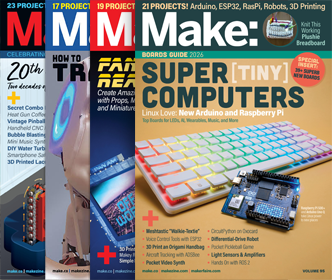HOW TO – Build a Cool Linux Toy…

Pramode C.E. writes – “With a low-cost general purpose microcontroller like the PIC16F628, bits and pieces of cheap, commonly available electronics components, and LOTS of code, you can build many interesting `toys’ and hook them up to your Linux machine – a really great learning experience for the hardware hacker who wants to learn Linux, or the Linux hacker who wants to learn a bit of hardware. This article describes how I went about building my temperature-sensing project – amateur Linux/hardware hackers might find some of the ideas useful when they start building things on their own.” Link.



 Excellent suggestions on a DIY spam filtering solution on
Excellent suggestions on a DIY spam filtering solution on 
 Chris writes in with something to do with a laptop keyboard: “Ever wanted a laptop keyboard to use with your stationary computer? Lee Char did and took a keyboard from an old Compaq and ‘converted’ it to be connected to his regular computer. This is something that would be interesting to spin further on by interfacing this keyboard with an PDA instead, like an iPAQ. Anyone have an idea on how to do this?”
Chris writes in with something to do with a laptop keyboard: “Ever wanted a laptop keyboard to use with your stationary computer? Lee Char did and took a keyboard from an old Compaq and ‘converted’ it to be connected to his regular computer. This is something that would be interesting to spin further on by interfacing this keyboard with an PDA instead, like an iPAQ. Anyone have an idea on how to do this?” 
 We spent some time with the new Intel-based Macbook. Wow–it’s super fast. As we take photos, we’re automatically uploading them to Flickr via WiFi-Kodak wireless camera and the roaming EVDO Wifi network we’re broadcasting — so here they are, some of the first photos with hot system info action, too!
We spent some time with the new Intel-based Macbook. Wow–it’s super fast. As we take photos, we’re automatically uploading them to Flickr via WiFi-Kodak wireless camera and the roaming EVDO Wifi network we’re broadcasting — so here they are, some of the first photos with hot system info action, too! 
 Chad writes “For a while I have wanted to control things with a serial port. It was pretty easy to control a relay with a serial port. With a standard serial port you can control 2 relays. (with a parallel port you can control 8 relays, but I don’t have a parallel port on my system). A standard PC serial port has 9 pins. Pin 4 – DTR (data terminal ready) and Pin 7 – RTS (request to send) can be used to control a relay. These two ports don’t actually send data. They are used to signal the other device to tell it when to send data.” Here’s the HOW TO –
Chad writes “For a while I have wanted to control things with a serial port. It was pretty easy to control a relay with a serial port. With a standard serial port you can control 2 relays. (with a parallel port you can control 8 relays, but I don’t have a parallel port on my system). A standard PC serial port has 9 pins. Pin 4 – DTR (data terminal ready) and Pin 7 – RTS (request to send) can be used to control a relay. These two ports don’t actually send data. They are used to signal the other device to tell it when to send data.” Here’s the HOW TO – 
 Turn your optical mouse in to a scanner! Erik writes: “A Maker posted his project on a very large Dutch forum, after he read some datasheets of the sensor in his optical mouse. He wrote a application in VB for reading the sensors outputs, so he can use the sensor like a hand scanner. The software is available on the site and works on mice which use an ADNS-2610 optical sensor, recognisable by the eight pins, the sun-like mark and the text ‘A2610’.”
Turn your optical mouse in to a scanner! Erik writes: “A Maker posted his project on a very large Dutch forum, after he read some datasheets of the sensor in his optical mouse. He wrote a application in VB for reading the sensors outputs, so he can use the sensor like a hand scanner. The software is available on the site and works on mice which use an ADNS-2610 optical sensor, recognisable by the eight pins, the sun-like mark and the text ‘A2610’.” 
 This is a trend I think we’ll see over and over again this year with phones and the music stores carriers are going to roll out – the slow death of MP3 playback on phones, or having to have a Windows PC and Media player 10 to convert to WMA before your phone can play your music. Techdirt has a story about Verizon phones that will no longer play MP3s one upgraded to use their new music store, if customers complain they’ll get an old refurbished phone with older firmware, but it doesn’t appear that the user is warned before updating that they’ll lose their MP3 playing feature. [
This is a trend I think we’ll see over and over again this year with phones and the music stores carriers are going to roll out – the slow death of MP3 playback on phones, or having to have a Windows PC and Media player 10 to convert to WMA before your phone can play your music. Techdirt has a story about Verizon phones that will no longer play MP3s one upgraded to use their new music store, if customers complain they’ll get an old refurbished phone with older firmware, but it doesn’t appear that the user is warned before updating that they’ll lose their MP3 playing feature. [